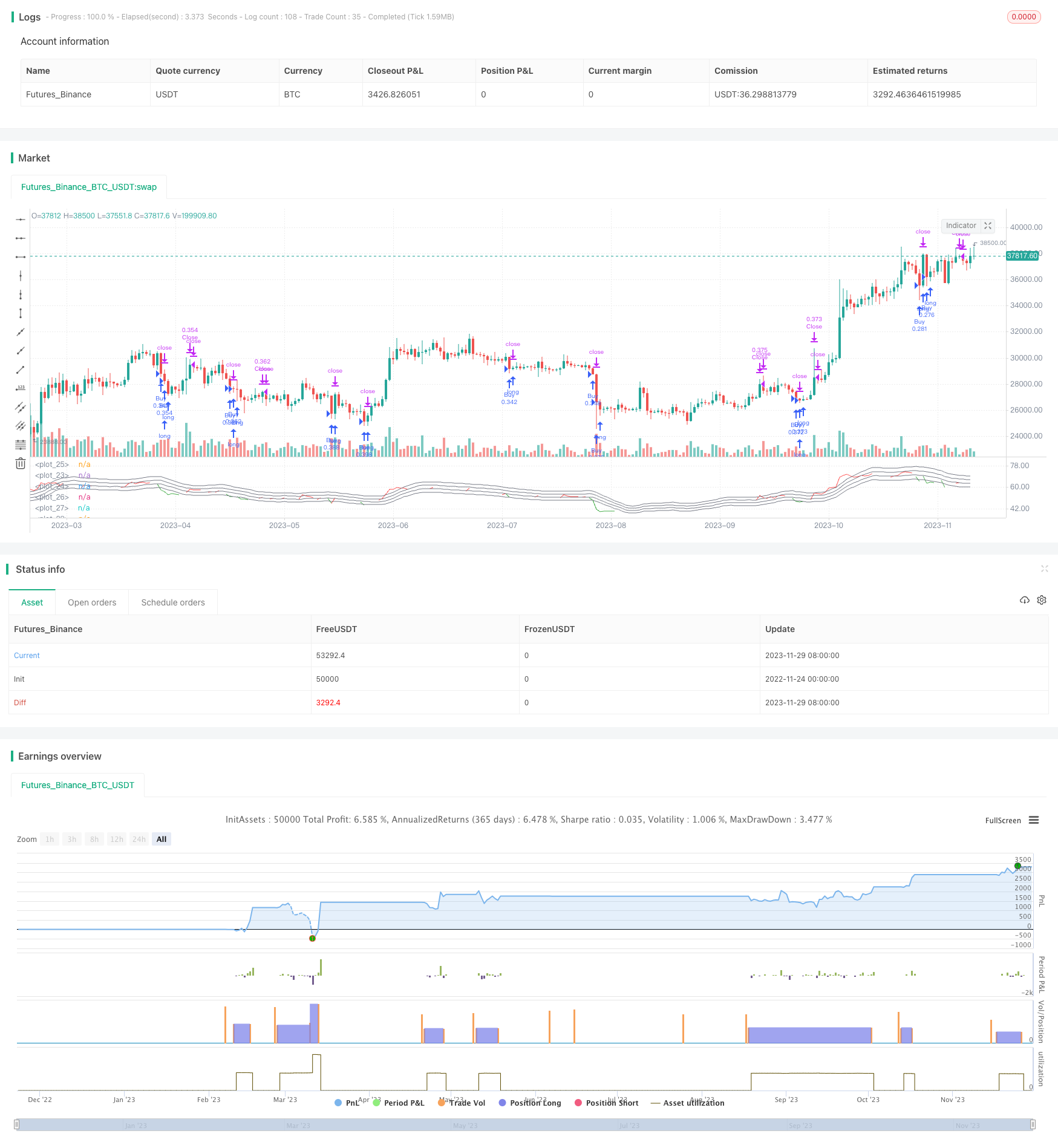
개요
이 전략은 RSI 지표와 그 평균선의 교차를 통해 매매점을 결정하며, 단선 거래 전략에 속한다. 이 전략은 RSI 지표가 그 평균선보다 낮을 때 구매하고, 그 평균선보다 높을 때 판매하며, 전형적인 낮은 가격으로 높은 가격으로 판매하는 전략에 속한다.
전략 원칙
- RSI를 계산합니다. 주기는 40 K선입니다.
- RSI 지표에 대한 MA 평균선 계산, 주기의 길이는 10 K 선
- RSI 지표가 평균선보다 낮을 때 구매 신호를 생성하는 계수 ((1-매매 간격/100)
- RSI 지표가 평균보다 높을 때 매매 신호를 생성합니다.
- 구매/판매 구간 간격이 기본으로 5인 경우, 평균선에서 ±5% 떨어져서 신호가 발생한다.
- RSI 지표가 평균보다 높고 50 수준 이상으로 평형 지점을 판단할 때
우위 분석
이것은 전형적인 트렌드 리버스 전략으로 RSI 지표의 오버 바이 오버 셀 특성을 이용해서 구매 시점을 결정한다. 이 전략에는 다음과 같은 장점이 있다:
- RSI 지표를 사용하여 시장 구조를 판단하고, 지표 자체는 신뢰성이 높습니다.
- 일선 필터링은 불필요한 거래를 방지하고 안정성을 강화합니다.
- 거래 빈도를 조정할 수 있는 거래 구역 간격 변수
- 코드는 간단하고 이해하기 쉬우며, 논리가 명확합니다.
전체적으로 볼 때, 이것은 간단하고 실용적인 단선 거래 전략입니다.
위험 분석
이 전략에는 몇 가지 위험도 있습니다.
- RSI 지표가 잘못된 신호를 발산할 가능성이 높으며, 지표 곡선의 형태에 주의를 기울여야 합니다.
- 구매 및 판매 간격이 잘못 설정되면 거래가 너무 많거나 기회를 놓치게 될 수 있습니다.
- 거래 빈도가 높기 때문에 거래 비용의 영향을 고려해야 합니다.
- 단 하나의 지표에 기반하여 시장의 변동에 취약하다.
이러한 위험은 매개 변수 최적화, 필터링 조건을 추가하는 등의 방법으로 완화될 수 있다.
최적화 방향
이 전략은 다음과 같은 차원에서 최적화될 수 있습니다.
- 거래량 지표와 같은 더 많은 필터링 지표를 추가하여 트렌드 전환점에서만 신호를 생성하도록합니다.
- 단독 손실을 통제하기 위한 HAL 전략에 참여하세요.
- 거래 거리를 최적화하고 거래 빈도와 수익률을 균형 잡는다.
- 기계 학습 알고리즘을 사용하여 우수 변수 조합을 자동으로 찾습니다.
- 포괄 모형을 추가하여 여러 하위 전략 결과를 통합합니다.
다중 지표 조합, 손해 관리, 변수 최적화 등의 수단으로 전략 성과를 크게 향상시킬 수 있다.
요약하다
이 전략은 전체적으로 매우 전형적이고 실용적인 짧은 라인 거래 전략이다. RSI 지표의 오버 바이 오버 셀 상태를 사용하여 매매 시기를 판단하고, 평평한 필터링으로 보조한다. 전략 논리는 간단하고 명확하며, 매개 변수를 조정하는 것은 유연하며, 구현하기 쉽다.
전략 소스 코드
/*backtest
start: 2022-11-24 00:00:00
end: 2023-11-30 00:00:00
period: 1d
basePeriod: 1h
exchanges: [{"eid":"Futures_Binance","currency":"BTC_USDT"}]
*/
// This source code is subject to the terms of the Mozilla Public License 2.0 at https://mozilla.org/MPL/2.0/
// © I11L
//@version=5
strategy("I11L - Meanreverter 4h", overlay=false, pyramiding=3, default_qty_value=10000, initial_capital=10000, default_qty_type=strategy.cash,process_orders_on_close=false, calc_on_every_tick=false)
frequency = input.int(10)
rsiFrequency = input.int(40)
buyZoneDistance = input.int(5)
avgDownATRSum = input.int(3)
useAbsoluteRSIBarrier = input.bool(true)
barrierLevel = 50//input.int(50)
momentumRSI = ta.rsi(close,rsiFrequency)
momentumRSI_slow = ta.sma(momentumRSI,frequency)
isBuy = momentumRSI < momentumRSI_slow*(1-buyZoneDistance/100) and (strategy.position_avg_price - math.sum(ta.atr(20),avgDownATRSum)*strategy.opentrades > close or strategy.opentrades == 0 ) //and (momentumRSI < barrierLevel or not(useAbsoluteRSIBarrier))
isShort = momentumRSI > momentumRSI_slow*(1+buyZoneDistance/100) and (strategy.position_avg_price - math.sum(ta.atr(20),avgDownATRSum)*strategy.opentrades > close or strategy.opentrades == 0 ) and (momentumRSI > barrierLevel or not(useAbsoluteRSIBarrier))
momentumRSISoftClose = (momentumRSI > momentumRSI_slow) and (momentumRSI > barrierLevel or not(useAbsoluteRSIBarrier))
isClose = momentumRSISoftClose
plot(momentumRSI,color=isClose ? color.red : momentumRSI < momentumRSI_slow*(1-buyZoneDistance/100) ? color.green : color.white)
plot(momentumRSI_slow,color=color.gray)
plot(barrierLevel,color=useAbsoluteRSIBarrier ? color.white : color.rgb(0,0,0,0))
plot(momentumRSI_slow*(1-buyZoneDistance/100),color=color.gray)
plot(momentumRSI_slow*(1+buyZoneDistance/100),color=color.gray)
plot(momentumRSI_slow*(1+(buyZoneDistance*2)/100),color=color.gray)
// plot(strategy.wintrades - strategy.losstrades)
if(isBuy)
strategy.entry("Buy",strategy.long, comment="#"+str.tostring(strategy.opentrades+1))
// if(isShort)
// strategy.entry("Sell",strategy.short, comment="#"+str.tostring(strategy.opentrades+1))
if(isClose)
strategy.exit("Close",limit=close)